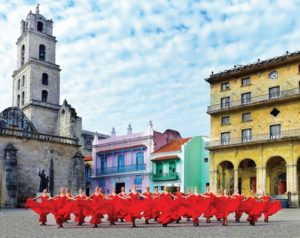Lizt Alfonso Dance Cuba: At the crossroads of a culture in interesting times - Vancouver Ballet Society
- Home
- Features 2015 - 2019
- Lizt Alfonso Dance Cuba: At the crossroads of a culture in interesting times

by Toba Singer
It inspires Lizt Alfonso that Cuban dance is broader than its renowned achievements in classical ballet. She credits both that breadth and the founders of Cuba’s classical training system — Alicia Alonso and her former husband Fernando Alonso — for shaping her work today. “Cubans dance from birth,” she says. “How we move, feel rhythm and music, is in our blood, passed from generation to generation in a natural way. At the same time, Alicia and Fernando Alonso, and the many teachers they trained who trained us, gave us a solid classical foundation.”
Acceptance in the ballet studio came to Alfonso slowly. She did not meet the physical requirements for classical ballet, which Cubans sum up in one word, condiciones. Yet, after seeing the Cuban National Ballet perform Coppélia, at age four, all she wanted was to dance ballet.

At nine, she auditioned for the Provincial School of Ballet Alejo Carpentier, the first stop for a serious-minded dancer on the path to the National School of the Arts, which aims to produce high-calibre professional ballet dancers. She was rejected. Her mother then enrolled her at Centro ProDanza, where, after several months with the exacting Laura Alonso (the daughter of Alicia and Fernando), she reapplied to Alejo Carpentier and was accepted. For six years, she studied ballet, character, period dances and a host of related subjects.
As it turned out, Alfonso ended up earning a bachelor’s degree in ballet arts from the Instituto Superior de Arte in 1990. In an essay written during her studies, she points to a proliferation of companies in the Cuban dance scene that had gained momentum in the 1980s. By the 1990s, besides the Cuban National Ballet, Ballet de Camagüey and several smaller contemporary companies, Cuba also had groups that specialized in diverse genres, such as folkloric or flamenco.
Cuba had enacted Law 812 in the first days of its 1959 revolution, which stated that the government must fund the national ballet company, the Ballet of Cuba, known today as the Cuban National Ballet. The newer companies found it harder to wrest funding from the Ministry of Culture, and the ones that did promoted one distinct dance style. Many colleagues discouraged Alfonso from taking the risk of creating a company based on eclectic styles, as she intended: it simply had never been done before.
Alfonso, however, says, “Doors should remain open; nobody has a right to limit a person’s creative capacity to push open space in the arts universe.”
During her one-year tenure as Centro ProDanza’s director, Alfonso began using studio space there to work with a small group of dancers that initially included Cuban National Ballet principal Galina Alvarez and José Manuel Carreño, who went on to dance as a principal with American Ballet Theatre. As the group developed, it became Danza Ibéricas, which in 1991 took on an independent life as Lizt Alfonso Dance Cuba.
As Alfonso describes it, “Our company is atypical because we put a mix of styles onstage in a single program, presenting a seamless and harmonic mix of Cuban dance.” This ranges from Yoruba drum-inspired folkloric, to rumba, to contemporary ballet, to Latin jazz and ballroom. “Our repertoire goes from the most authentic dance from our roots and musical fusion, to the great musicals staged by Ramiro Guerra and Luis Trapaga in the 1960s and ’70s,” says Alfonso.
In its first years, Lizt Alfonso Dance Cuba was in survival mode, but, by 2000, she says, “We had performed in Spain and the United States. At that point, the National Council of the Performing Arts offered a small state subsidy, which we appreciated because it showed the government’s recognition of the role we play in our nation’s cultural history.”
In 2002, Fidel Castro, then-president of Cuba, became interested in their work. “He asked what we needed to keep growing,” Alfonso says. “I requested a studio. He said that if we continued to grow so fast, one studio wouldn’t be enough, that we should think about a bigger place. I knew of space in the Havana Historians Office building and thanks in no small way to Fidel’s support, the company now has a fully restored and renovated headquarters in the heart of Old Havana. We are also a resident company at the Gran Teatro Alicia Alonso. Still, we keep our old headquarters. It offers new generations continuity with our beginnings.”
At a White House ceremony in 2016, then-First Lady Michelle Obama presented Lizt Alfonso Dance Cuba with the International Spotlight Award. This followed then-President Barak Obama’s historic visit to Cuba, touted as an effort to restore U.S.-Cuban relations.
What was it like to receive the award in light of the ongoing economic embargo on trade and travel between the countries?
Alfonso was overjoyed at having the company’s work valued by the American stage, screen and literary artists on the jury. It deepened her belief that the role the company plays as a goodwill ambassador can have a positive impact on ending the embargo. She also sees her company as a means for communicating the dynamism of Cuban dance culture to those whose access to Cuba is impeded by the embargo.
As an example, she cites audiences in Israel, which is the only country besides the United States to have supported the embargo in a recent United Nations roll call vote.
“Our successful tour of Israel in November 2017 demonstrated how our efforts have borne fruit and grown. Both Israeli audiences and the press welcomed us with an abundance of enthusiasm.”

